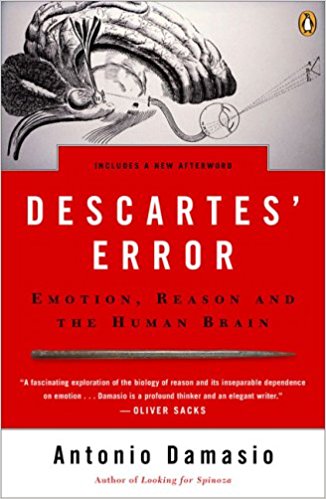 This book is a bit long in the tooth now, having been published in ’95. The role it suggests for emotion in the use of reason is, in generalities, no longer controversial. But it was a landmark book for me, when I read it, and it’s still relevant and worth reading.
This book is a bit long in the tooth now, having been published in ’95. The role it suggests for emotion in the use of reason is, in generalities, no longer controversial. But it was a landmark book for me, when I read it, and it’s still relevant and worth reading.
There’s been a LOT of work around how reason and emotion work together, or don’t. One popular model is “thinking fast and thinking slow,” with emotion as primary in the first, and reason the second.
There’s truth to this, but it’s only a partial truth. In complicated situations, reason does not work alone and can’t.
The human mind is limited, it simply cannot hold a lot of information at one time. Working memory holds about seven bits of information. Some people have a little more, some a little less, and there’s some variation on how much can be held based on the complexity of what is held.
Impressive memory tricks are mostly a result of clumping information into meaningful bits. One strategy for memorizing numbers is to do them as times, for example, making each bit longer.
Logic can work in two ways: sequentially and in parallel. In parallel it can only work up to the limit of working memory. Sequentially we can work through logical chains, but long chains run up against the working memory limitation in their own way–after a time, we don’t really remember the chain.
Humans, for all that we pat ourselves on the back a lot, are fundamentally stupid. It’s just that most other animals are terrible, and those who might be about as good as us or even better are, in some ways, handicapped otherwise, in terms of hands, and/or language, and/or lifespan (octopi), and so on.
Damasio notes that the realm of pure reason is very limited. Most decisions are not obvious. One example he gives is of a patient who has lost the ability to feel emotions trying to decide when his next appointment should be. It’s not obvious, and he can’t do it, he can spend hours trying to decide.
This same patient, however, in a potential motor vehicle accident where there is an obvious solution, has no problem. Because he feels no emotions, he does the right thing and it’s no big deal for him.
Emotions are really body-states. You feel all emotions in your body. If you don’t, you don’t feel an emotion. (Meditation will show this to you experientially, if you wish.)
We remember emotions and we re-create them as necessary. (Remember the last time you hugged someone you love, feel the emotion. To enhance it, stand and physically mimic hugging them.)
We assign these emotions even to very subtle things, like logical propositions and thoughts on subjects.
When a problem is too hard to deal with using pure reason, when it’s not important enough to subject to pure reason, or when there is no time for pure reason (because logical thinking is, indeed, SLOW), we refer to our feelings, and we go with the one that feels best (or least worst).
Thinking is rarely divided into “pure reasoning” (slow) or “pure feeling” (fast), most complicated decisions use both.
More to the point, most hard decisions are hard because they aren’t clear: There isn’t an obvious logical choice. They’re close calls, and, in such decisions, we will go with the decision that feels best.
So pure reason is rare, slow, and usually only used for decisions that are, actually, clear cut.
This has a lot of implications, but the one I want to end with is this: Your emotional map of reality is most of your intelligence and if your emotional map of reality (or any decision space within reality) is not accurate, you’re going to make a lot of bad decisions.
This, though Damasio does not go into it, is where ideology and identity come into things. Through those two methods (and anyone who doesn’t think they have an ideology is a fool), we build emotional maps we then layer on top of reason. If our identities or ideologies are screwed, we make bad decisions.
This is an important book to read. Even if all details are not accurate, it is a necessary antidote to a lot of foolishness about how thinking and decision-making actually works.
The results of the work I do, like this article, are free, but food isn’t, so if you value my work, please DONATE or SUBSCRIBE.
